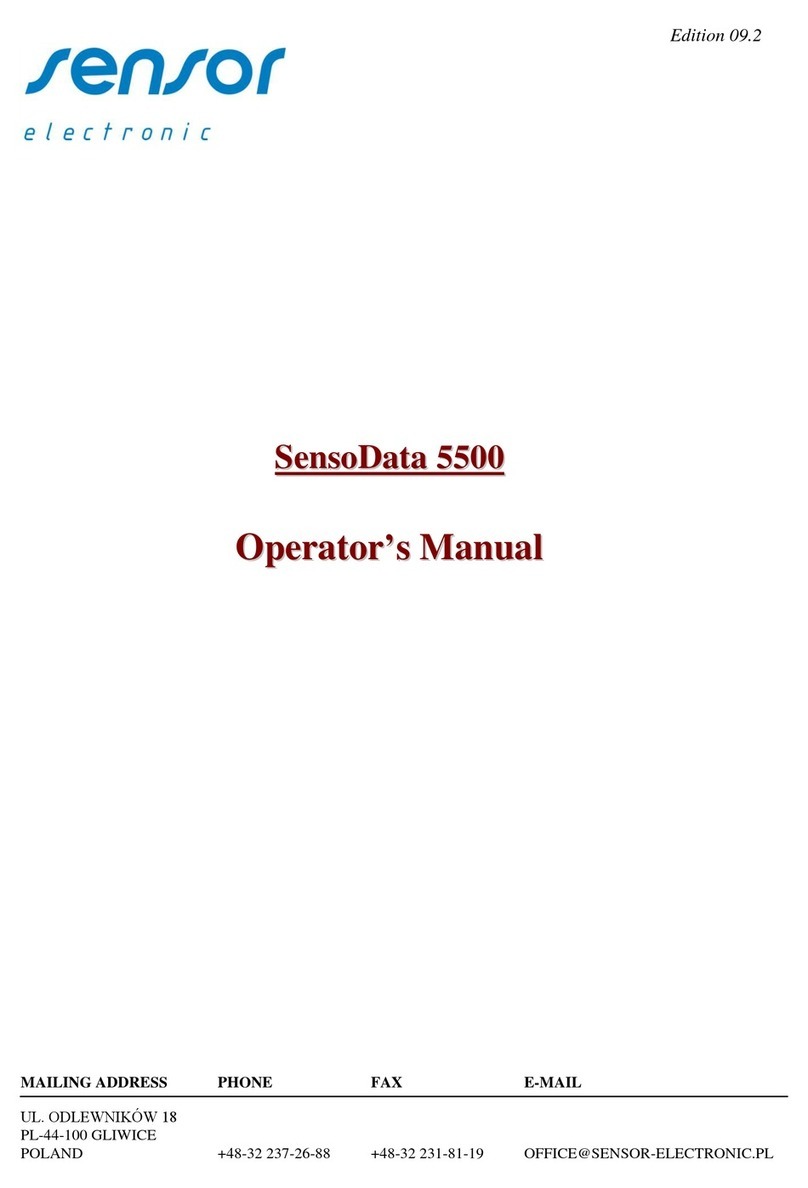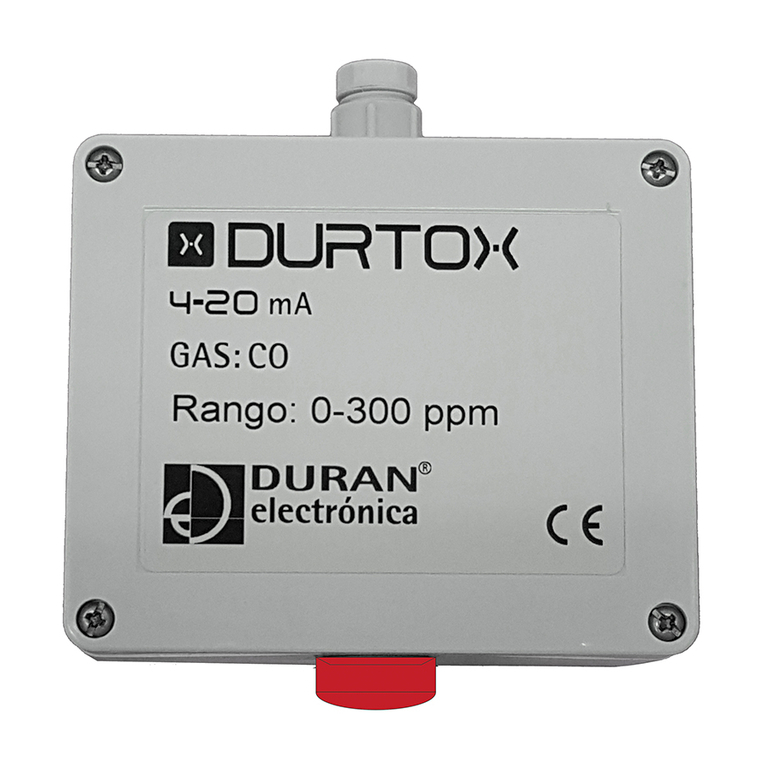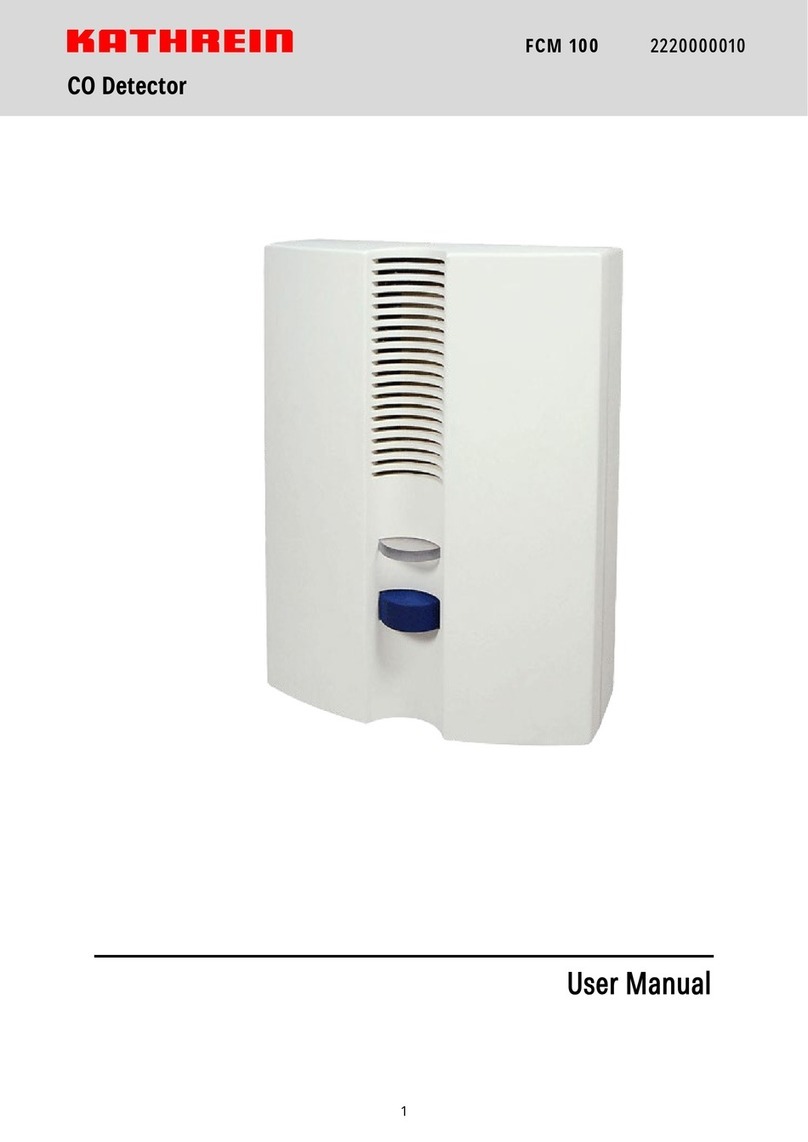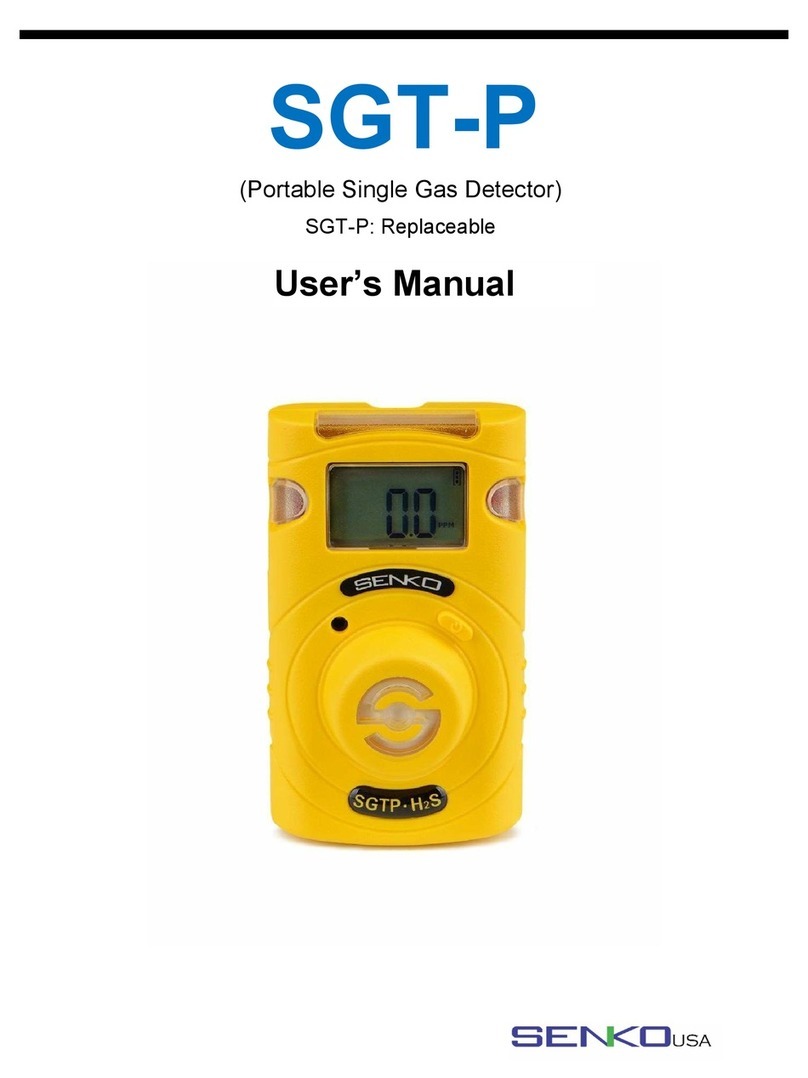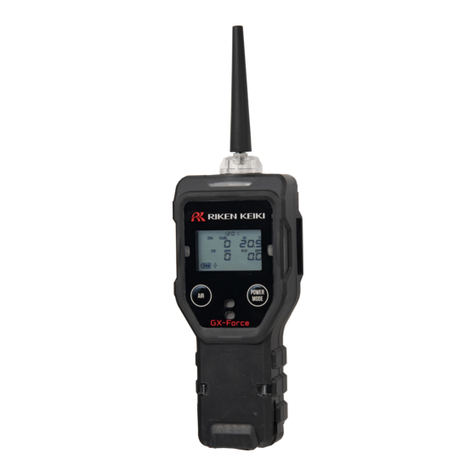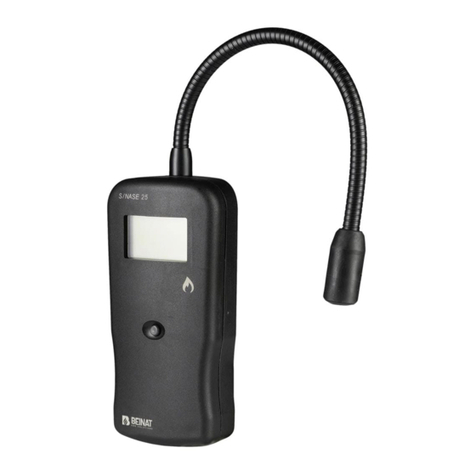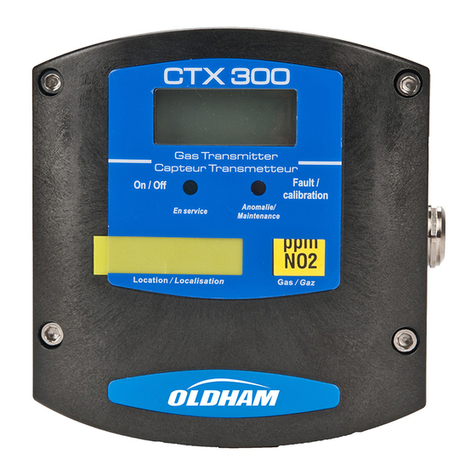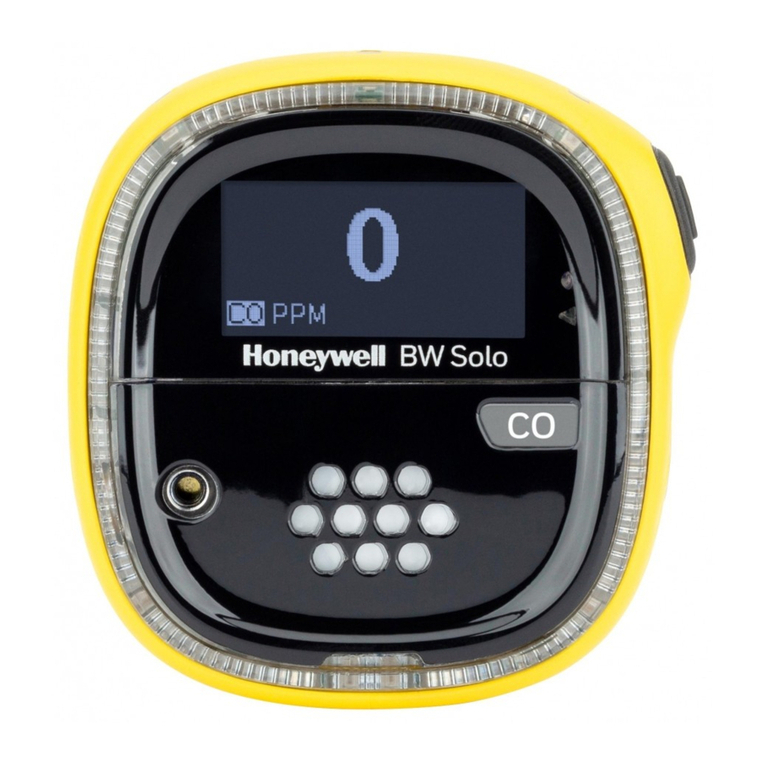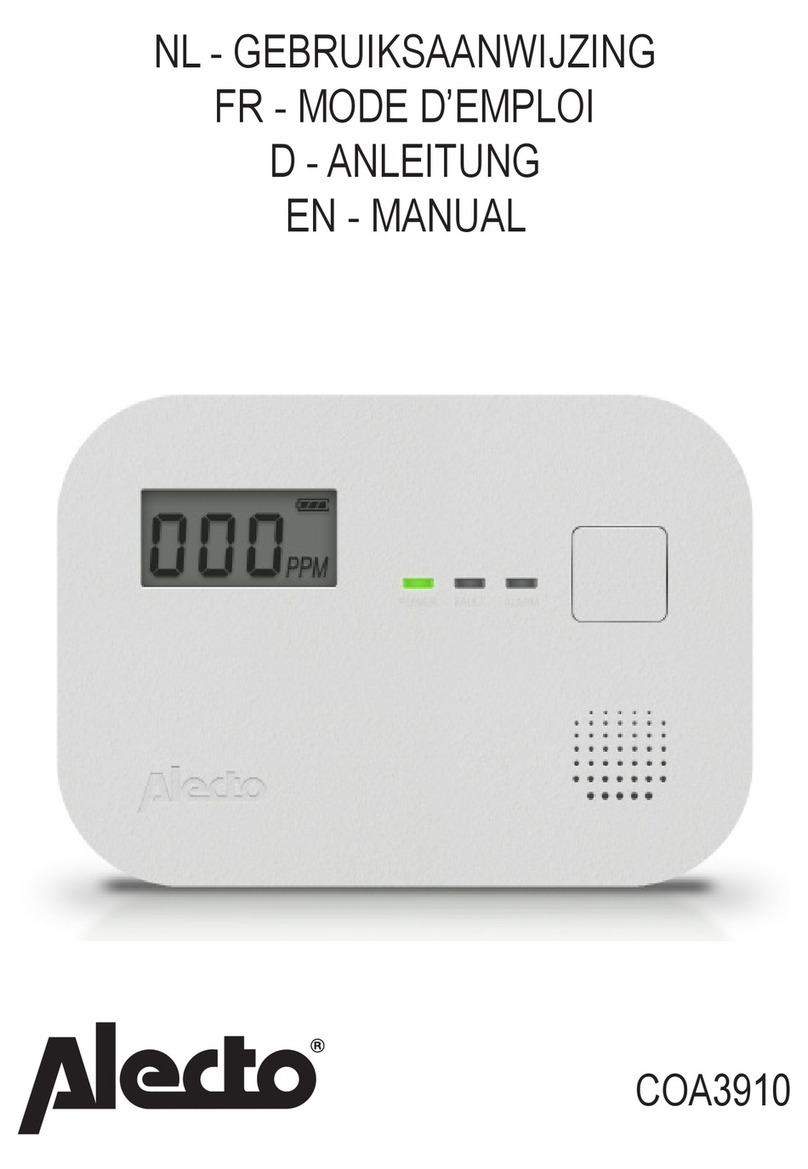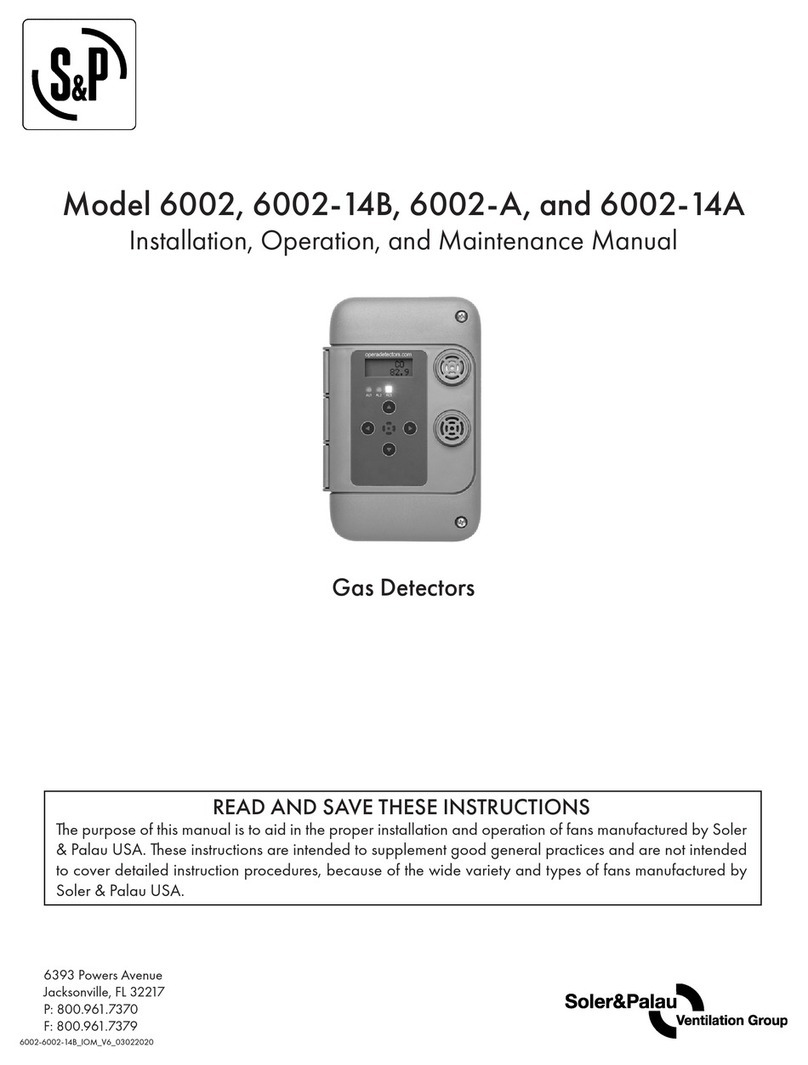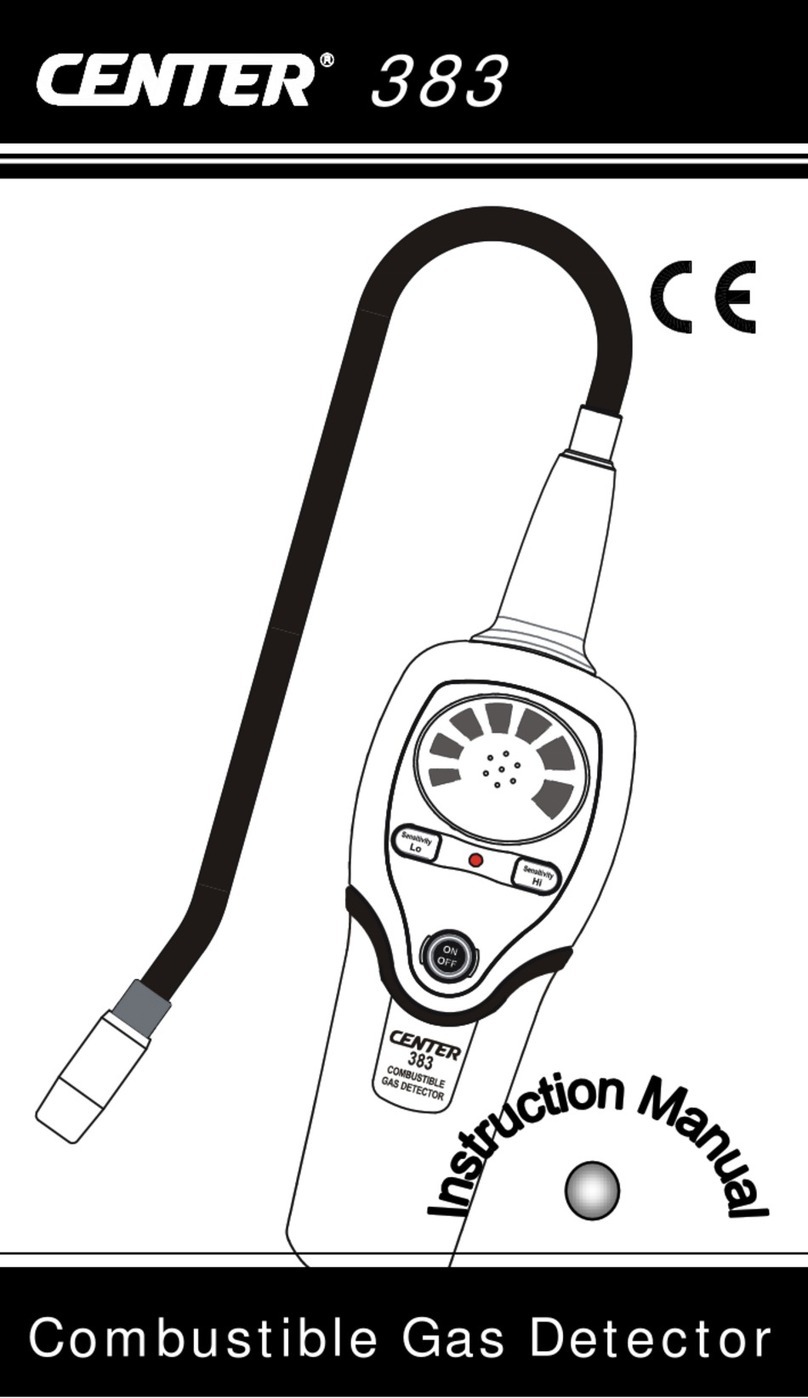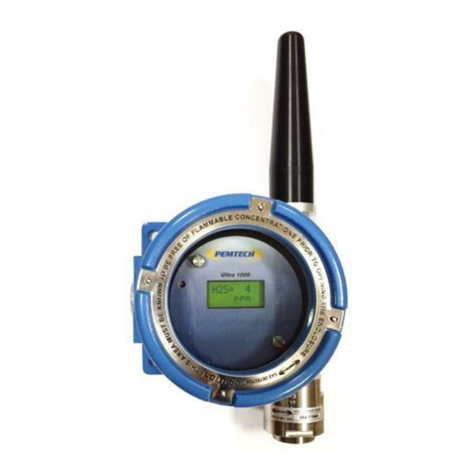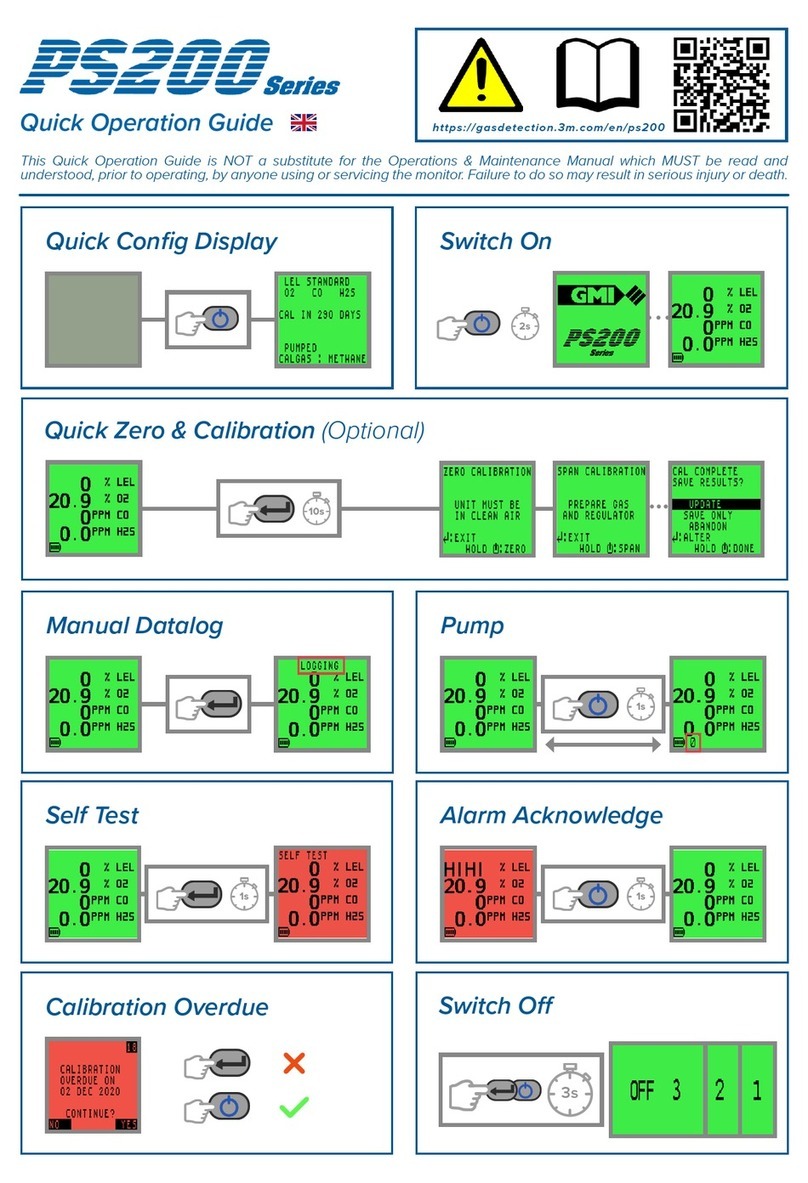Sensor Electronics SEC Millenium Series Manual

Sensor Electronics Corporation
12730 Creek View Avenue
Savage, Minnesota 55378
Gas Detection Systems
Training Manual
August 2017

SEC 3000 Gas Detector
© 09/13
• Compact low cost design
• No field gas calibration required
• Intrinsically safe & explosion proof
• Universal control board
• Interchangeable sensor modules for oxygen and toxic gases
• Temperature compensated sensor
• Stand alone gas detector with 4-20 mA output
• Corrosion resistant 316 stainless steel housing construction
• Long life electrochemical sensors
• Can be mated with SEC 3100 Transmitter
• Optional heater with closed loop temperature control ensures accuracy in
low temperature applications
Features
• Petrochemical • LNG & LPG Processing
• Medical • Waste Water
• Semi Conductor • Water Treatment
• Mining • Chemical
• Pulp and Paper • Automotive
• Offshore • Pharmaceutical
• Fertilizer • Refrigeration
Industries
Operation
The SEC 3000 gas detector is a unique design combining intrinsically safe and explosion proof
approved standards. This allows for quick and simple field installation of a calibrated sensor module into
the gas detector in hazardous locations with power applied.
The SEC 3000 sensor module retains operating parameters and calibration settings. Once the sensor
module is plugged into the gas detector, the sensor module automatically uploads current information to
the control board in the SEC 3000. Changing to a different type of gas sensor is accomplished by only
changing the sensor module board. The existing housing and wiring remains intact.
An industry standard 4-20 mA analog output provides remote alarm, fault and calibration signals. The
entire unit utilizes self-diagnostics, identifies problems and continuously transmits status.
The SEC 3000 can be used inconjunction with the SEC 3100 explosion proof transmitter. The SEC 3100
has a backlit LCD display, non-intrusive local calibration, 4-20 mA output, non-intrusive local configura-
tion, optional relays, RS485 interface and intrinsic barrier.

Sensor Electronics Corporation
12730 Creek View Avenue, Savage, MN 55378 U.S.A. • (800) 285-3651 • (952) 938-9486 • FAX: (952) 938-9617
www.sensorelectronic.com • [email protected]
© 09/13
Detection Method:
Electrochemical or Galvanic
Sampling Method:
Diffusion
Optional sample draw (requires 1 liter per
minute sample flow rate)
Output (Analog):
4-20 mA (source type), max. 1000 Ohm load
at 24 VDC supply voltage
Output (Digital):
Interactive Interface Available On The
Calibration (White) Wire
Construction:
316 Stainless Steel Explosion Proof
Accuracy:
+/- 5%
Lower Detectable Limit:
1% of Full Scale (Under Ideal Conditions)
Recommended Minimum Alarm Setting:
10% of Full Scale
Temperature Rating:
Toxic gas sensors temperature range may vary.
Please consult with Sensor Electronics.
Operating Voltage:
24 VDC ______ Operating range: 8 to 32 VDC
measured at the detector head
Power Consumption
1-2 Watt Max.
Max. Current Draw
50 mA (at 24 VDC)
Approvals:
CSA: Class 1, Div 1, Groups B,C,D, T6
CSA: Intrinsically Safe, Groups A,B,C,D,T4
Installation Category:
Cat. I, Pollution Degree 2
SEC 3000 Gas Detector
Specifications
Current Output Status
0.0 mA Unit Fault
0.8 mA Unit warm up
1.2 mA Zero drift fault
1.6 mA Calibration fault
2.0 mA Unit spanning
2.2 mA Unit zeroing
4-20 mA Normal measuring mode
4.0 mA Zero gas level
5.6 mA 10% Full Scale
8.0 mA 25% Full Scale
12 mA 50% Full Scale
16 mA 75% Full Scale
20 mA Full scale
>20 mA Over-range
Partial Gas List
Oxygen (O2) Carbon Monoxide (CO)
Hydrogen (H2) Germane (GeH4)
Ammonia (NH3) Silane (SiH4)
Nitric Oxide (NO) Phosphine (PH3)
Bromine (Br2) Sulfur Dioxide (SO2)
Fluorine (F2) Nitrogen Dioxide (NO2)
Arsine (AsH3) Chlorine Dioxide (ClO2)
Ozone (O3) Hydrogen Sulfide (H2S)
Chlorine (Cl2) Hydrogen Fluoride (HF)
Phosgene (COCl2) Hydrogen Chloride (HCl)
Diborane (B2H6) Hydrogen Cyanide (HCN)
Formaldehyde (HCHO) Hydrogen Selenide (H2Se)
Ethylene Oxide (ETO) Hydrogen Peroxide (H2O2)
_ _ _

Doc#: 1460003, Rev A Operation Manual, SEC 3000 Electro-Chemical Gas Sensor Page 2of 13
Commitment
Our quality and service are uncompromising. We back each of our products with a two-year warranty on all
materials and workmanship. We offer technical support, user training and on-site service and maintenance
of equipment to meet the needs of our customers.
Gas Detection Service
Individually designed maintenance packages are available for specific customer needs. Service begins with
verification of the system installation that includes an initial system check and calibration. We then offer
customer training programs (on-site and at factory) to insure that technical personnel fully understand
operation and maintenance procedures. When on-the-spot assistance is required, service representatives
are available to handle any questions or problems immediately.
Warranty
Sensor Electronics Corporation (SEC) warrants products manufactured by SEC to be free from defects in
workmanship and materials for a period of two (2) years from date of shipment from the factory. Any parts
returned freight pre-paid to the factory and found defective within the warranty would be repaired or
replaced, at SEC's option. SEC will return repaired or replaced equipment pre-paid lowest cost freight. This
warranty does not apply to items, which by their nature are subject to deterioration or consumption in normal
service. Such items may include:
Fuses and Batteries
Warranty is voided by abuse including rough handling, mechanical damage, alteration or repair. This
warranty covers the full extent of SEC liability and SEC is not responsible for removal, replacement costs,
local repair costs, transportation costs or contingent expenses incurred without prior written approval.
Sensor Electronics Corporation's obligation under this warranty shall be limited to repair or replacement of
any product that has been returned to Sensor Electronics Corporation for warranty consideration. This
warranty is expressly in lieu of any and all other warranties expressed or implied, and all other obligations or
liabilities on the part of Sensor Electronics Corporation including but not limited to, the fitness for a particular
purpose. In no event shall Sensor Electronics Corporation be liable for direct, incidental, or consequential
loss or damage of any kind connected with the use of its products or failure to function or operate properly.
WARNING: READ AND UNDERSTAND THE USER’S MANUAL BEFORE OPERATING
OR SERVICING
WARNING: KEEP COVER TIGHT WHILE CIRCUITS ARE LIVE
CAUTION: FOR SAFETY REASONS THIS EQUIPMENT MUST BE OPERATED AND
SERVICED BY QUALIFIED PERSONEL ONLY

Doc#: 1460003, Rev A Operation Manual, SEC 3000 Electro-Chemical Gas Sensor Page 3of 13
Revision History
Rev
Date
Description of Change
Page
A
Aug 2015
Assign new part number, place under ECO control
All (footer)
Correct Temp Specifications to align with certifications
4
Add Caution and Warning Statements
2
Remove Y2K Disclaimer (obsolete)
1
31015
Oct 2013
Part Number 75-3000
Update Company Address
Cover
091404
Sep 2004
Revision History Undocumented
Table of Contents
Revision History........................................................................................................3
I. SPECIFICATIONS................................................................................................4
II GENERAL DESCRIPTION ..................................................................................5
III. OPERATION ......................................................................................................6
IV. CALIBRATION..................................................................................................8
V. MAINTENANCE.................................................................................................9
VI. Parts List .............................................................................................................9
Cross Sensitivity Table............................................................................................10
VII. Drawing Section...............................................................................................11
Part Number Construction.......................................................................................13

Doc#: 1460003, Rev A Operation Manual, SEC 3000 Electro-Chemical Gas Sensor Page 4of 13
I. SPECIFICATIONS
Model: SEC 3000 Gas Detector
Model Number: SEC3000
Available gases:
Ammonia Carbon Monoxide Hydrogen
Nitric Oxide Oxygen Phosgene
Bromine Chlorine Chlorine Dioxide
Fluorine Hydrogen Peroxide Ozone
Hydrogen Chloride Hydrogen Cyanide Hydrogen Fluoride
Hydrogen Sulfide Nitrogen Dioxide Sulfur Dioxide
Arsine Diborane Germane
Hydrogen Selenide Phosphine Silane
Formaldehyde
Please note that this list is not all-inclusive. The SEC 3000 sensors can be calibrated for other toxic gases
provided a calibration gas is available. For more please contact Sensor Electronics Corporation.
Detection Method: Electrochemical or Galvanic
Aspiration:
Diffusion
Optional Sample Draw (requires 1 liter per minute sample flow rate)
Output (Analog): 4-20 mA (Source type), max. 1000 Ohm load at 24 VDC supply voltage
Output (Digital) Interactive Interface Available On The Calibration (White) Wire
Response Time: Varies for type of sensing element
Construction: 316 Stainless Steel Explosion Proof
Accuracy: +/- 5%
Operating Temperature Rating:
-40to +50C at 0 to 99% RH (non-condensing)
Operating Voltage:
8 to 32 VDC measured at the detector head
Power Consumption: 1 Watt Max.
Max. Current Draw: 40 mA (at 24 VDC)
Approvals:
Explosion Proof CSA c,us: Class I, Division 1, Groups B,C,D T6
IECEx CSA 13.00xx: Ex d IIB+H2 T4 Gb
Intrinsically Safe CSAc,us: Cl I, Division 1, Groups Vmax Imax Pmax Ci Li T-Code
ABCD 10.4V 148mA 1.2W 2.51uF 22.5uH T4
CD 16.4V 148mA 1.2W 2.51uF 22.5uH T4
D 26.3V 148mA 1.2W 2.51uF 22.5uH T4
IECEx CSA 13.00xx: Ex ia IIC T4 Ga
Installation Category: Cat. I, Pollution Degree 2

Doc#: 1460003, Rev A Operation Manual, SEC 3000 Electro-Chemical Gas Sensor Page 5of 13
II GENERAL DESCRIPTION
CONVENTIONS
The following conventions are used in this manual.
Warning Statement
VDC (DC Voltage)
SEC 3000
The SEC 3000 toxic gas detector is a microprocessor based intelligent gas detector that continuously
monitors toxic gases and vapors ideally suited for use in harsh environments.
The SEC 3000 is a stand-alone device providing a continuous 4 to 20 mA output.
Intrinsically Safe and Explosion Proof versions are available.
When operated with the appropriate Intrinsic Barrier, the IS SEC3000 allows cover removal and sensor
replacement without declassifying the area.
Each sensor comes calibrated and carries all operating parameters. Simply plugging the sensor board into
any SEC3000 base results in a calibrated fully functional unit.
WARNING: SUBSTITUTION OF COMPONENTS MAY IMPAIR INTRINSIC SAFETY
AVERTISSEMENT: LA SUBSTITUTION DE COMPOSANTS PEUT
COMPROMETTRE LA SECURITE INTRINSEQUE
Features
Compact low cost design
No field gas calibration required
Intrinsically Safe and explosion proof
Universal control board
Interchangeable sensor modules for oxygen and toxic gases
Temperature compensated sensor
Stand alone gas detector with 4-20 mA sourced output
Corrosion resistant 316 stainless steel housing construction
Long life electrochemical sensors
Optional heater with closed loop temperature control ensures accuracy in low temperature applications
Can Be Coupled With SEC3100 Transmitter to Provide
Alarm and Fault Relays
Isolated RS485 Modbus Interface
Lighted LCD Display
Magnetic Switches For Unit Calibration Configuration

Doc#: 1460003, Rev A Operation Manual, SEC 3000 Electro-Chemical Gas Sensor Page 6of 13
III. OPERATION
Installation and Startup
Warning: The user shall be made aware that if the equipment is used in a manner not specified by the
manufacturer, the protection provided by the equipment may be impaired.
The first step in the installation process is to establish a mounting location for the SEC 3000. Select a
location that is typical of the atmosphere to be monitored or close to the anticipated source of a dangerous
gas.
It is very important that the SEC 3000 be properly located to enable it to provide maximum protection. The
most effective number and placement of sensors vary depending on the conditions of the application. When
determining where to locate sensors the following factors should be considered.
What are the characteristics of the gas that is to be detected? Is it lighter or heavier than air? If it is
lighter than air the sensor should be placed above the potential gas leak. Place the sensor close to the
floor for gases that are heavier than air or for vapors resulting from liquid spills. Note that air currents
can cause a gas that is heavier than air to rise. In addition, if the temperature of the gas is hotter than
ambient air or mixed with gases that are lighter than air, it could also rise.
How rapidly will the gas diffuse into the ambient air? Select a location for the sensor that is close to the
anticipated source of a gas leak.
Wind or ventilation characteristics of the immediate area must also be considered. Movement of air may
cause gas to accumulate more heavily in one area than in another. The detector should be placed in the
areas where the most concentrated accumulation of gas is anticipated. For outdoor applications with
strong wind conditions, it may require the sensors to be mounted closer together and on the down wind
side, to the anticipated area of a gas leak. Also take into consideration for indoor applications, the fact
that many ventilation systems do not operate continuously.
The sensor should be accessible for maintenance.
Excessive heat or vibration can cause premature failure of any electronic device and should be avoided
if possible.
Follow all national and local installation codes and practices.
The SEC 3000 has a ¾” NPT threaded connector for mounting the detector to a junction box. SEC can
provide a junction box with terminals for this purpose.
A user-supplied junction box can be used providing it has the appropriate sized NPT conduit entries. The
junction box must be suitable for use in the application and location in which it is being installed. After the
device has been installed, a calibration is required. Refer to the Calibration section of this manual.
Wiring connections
Red wire: 8 to 32 VDC
Black wire: DC Common
Blue wire: 4 to 20 mA output
White wire: Smart Calibration Wire (data wire)
Earth Ground: Two (2) grounding screws on SEC 3000 housing.
Wire sizing:
0 to 500 feet, recommended wire gauge size 16 AWG
501 to 1000 feet, recommended wire gauge size 14 AWG

Doc#: 1460003, Rev A Operation Manual, SEC 3000 Electro-Chemical Gas Sensor Page 7of 13
Shielded cable is recommended. Wiring should be installed in medal conduit with no other cabling in the
same conduit.
Warm-up
When power is applied to the detector, it enters a one (1) minute warm-up mode. The output current will be
0.8 mA during the warm up time period. At the end of the warm-up period with no faults present, the
detector automatically enters the normal operating mode (4 mA). If a fault is present after warm-up, the
detector current output will indicate a fault. See the following chart for fault code status. Some
electrochemical sensors will take up to 24 hours to stabilize. Newly installed sensors should be calibrated
after they have been allowed to stabilize.
Normal
In the normal operating mode, the 4 to 20 mA signal levels correspond to the detected gas concentration.
The detector continuously checks for system faults or initiation of calibration and automatically changes to
the appropriate mode.
The 4 to 20 mA output of the SEC 3000 is a non-isolated current source.
Current Output and Corresponding Status
Once the fault is cleared the SEC 3000 will automatically resume normal operation.
Current Output Status.
0-20 mA Normal measuring mode
0.0 mA Unit Fault
0.8 mA Unit warm up
1.2 mA Zero drift fault
1.6 mA Calibration fault
2.0 mA Unit spanning
2.2 mA Unit zeroing
4-20 mA Normal measuring mode
4.0 mA Zero gas level
5.6 mA 10% Full Scale
8.0 mA 25% Full Scale
12 mA 50% Full Scale
16 mA 75% Full Scale
20 mA Full scale
>20 mA Over-range

Doc#: 1460003, Rev A Operation Manual, SEC 3000 Electro-Chemical Gas Sensor Page 8of 13
IV. CALIBRATION
The SEC 3000 is factory calibrated, zeroed and spanned with calibration gas. After the SEC 3000 is
installed under power for 24 hours it should be calibrated (zeroed and spanned) with calibration gas.
Calibration frequency is dependent on the application and installation requirements. Typical calibration of
the gas sensors should be done on a quarterly basis.
The SEC 3000 sensor board is factory programmed with the following parameters. The parameters can be
changed using the SEC 3000 PC Link software package. Refer the SEC 3000 PC Link Instruction Manual
for additional information.
Gas Type
Range
Calibration Gas
Calibration Date
Sensor Bias Voltage (Not Adjustable)
If the calibration gas concentration is known, the SEC 3000 sensor can be zeroed and spanned in the field.
The SEC 3000 can also be calibrated using the SEC 3000 PC Link software package. Refer the SEC 3000
PC Link Instruction Manual for additional information.
Hardwire Calibration Method (For declassified areas)
Before beginning calibration attach the SEC 3000 Calibration Adaptor (PN 1421468) to the SEC 3000
sensor housing. The zero and span gas flow should be regulated to 1.0 liter per minute (LPM).
Zeroing the SEC 3000
Apply clean air or zero air (nitrogen for oxygen sensor).
Connect calibration wire (white wire on SEC 3000) to negative (black wire of SEC 3000, common of the
power supply) for ten (10) seconds, upon release the sensor will automatically enter the zero calibration
routine. The electronics will automatically adjust the sensor’s signal to the new zero reference level. During
the zero calibration routine, the current output of the SEC 3000 will briefly go to 2.2 mA. Although this can
be accomplished manually, installation of a switch (contact closure) can accomplish the zeroing procedure.
It is recommended that this switch be a momentary type switch to prevent it from inadvertently being left in
the calibrate position. If after 20 seconds the calibration lead has not been removed from common, the SEC
3000 will ignore the signal and continue operation as normal.
Spanning the SEC 3000
Apply the correct span gas concentration to the sensor (20.9% volume of O2 for oxygen sensor).
Connect calibration wire (white wire on SEC 3000) to positive (red wire of SEC 3000, +24 VDC of the power
supply) for ten (10) seconds; upon release the sensor will automatically enter the span calibration routine.
The electronics will automatically adjust the sensor’s signal to the new span reference level. During the span
calibration routine, the current output of the SEC 3000 will briefly go to 2.0 mA. Although this can be
accomplished manually, installation of a switch (contact closure) can accomplish the spanning procedure. It
is recommended that this switch be a momentary type switch to prevent it from inadvertently being left in the
calibrate position. If after 20 seconds the calibration lead has not been removed from +24 VDC, the SEC
3000 will ignore the signal and continue operation as normal.

Doc#: 1460003, Rev A Operation Manual, SEC 3000 Electro-Chemical Gas Sensor Page 9of 13
V. MAINTENANCE
The SEC 3000 does not normally require routine maintenance other than calibration. The only consumable
item on the SEC 3000 is the sensing element. The toxic gas sensing element will typically last for 2 years of
operation.
VI. Parts List
Part Number Description
1420636 SEC 3000 PC Link software package
1091000 Sensor Separation Kit
1421468 Cal Adapter
1421467 Splash Guard
1421467 Sample Draw Adapter

Doc#: 1460003, Rev A Operation Manual, SEC 3000 Electro-Chemical Gas Sensor Page 10 of 13
Cross sensitivity data was developed by exposure of sensors to gas concentrations below 100 PPM. Sensors may show either
transient or continuous responses different from those listed above if exposed to very high concentrations of gas. The values
shown are the equivalent signal generated by the sensor when exposed to 1 PPM of the indicated gas. For instance, exposure
of a chlorine (oxidant) sensor to 1 PPM of nitrogen dioxide would produce a sensor signal equivalent to 0.2 PPM chlorine.
Negative numbers indicate gases that can cause low readings when present with the target gas
* Indicates a three electrode sensor that requires a minimum of 5% oxygen for proper operation.
** Data shown for the chlorine sensor refers to the sensor used for bromine, chlorine, chlorine dioxide, fluorine or ozone.
Oxygen sensors will respond to halogen gases at % levels but are unaffected by low PPM levels.
Oxygen sensor response will be affected by % levels of CO2 but unaffected by low PPM levels.
NH3
Cl2**
HF
HCl
HCN
H2S
SO2
CO
H2
O2
NO
NO2
Hydride
SiH4
COCl2
Form.
ETO
NH3
-
N
0.05
N
N
N
N
N
N
N
N
N
N
N
N
N
N
CO
0.05
N
N
0.005
N
0.002
N
-
0.1
N
N
0.001
N
N
N
0.5
0.5
H2
0.02
N
N
0.01
0.01
0.001
0.005
0.1
-
N
0.001
0.001
0.00002
0.001
N
0.05
0.05
NO
N
N
N
1.5
3
0.4
0.04
0.1
N
N
-
N
N
0.3
0.1
0.8
0.8
O2
*
N
N
*
*
*
*
*
*
-
*
*
*
*
N
N
N
Cl2**
-0.1
-
1
N
N
N
-0.1
N
N
(1)
N
0.5
N
N
0.1
N
N
HCl
N
N
0.5
-
N
N
N
N
N
N
N
-0.3
N
N
0.05
0.2
0.2
HCN
N
-0.08
-0.1
0.01
-
N
0.15
0.1
N
N
N
-0.07
N
N
0.5
0.1
0.1
HF
N
N
-
N
N
N
N
N
N
N
N
N
N
N
N
N
N
H2S
0.3
-0.1
-0.3
3
N
-
N
N
N
N
N
-2.5
N
N
N
2
2
NO2
N
0.2
0.2
0.2
0.5
0.1
-0.8
N
N
N
N
-
N
N
-1
0.1
0.1
SO2
N
-0.01
1
0.5
2.0
0.1
-
N
N
N
N
-1
N
N
0.2
0.4
0.4
Hydri
de
0.5
N
N
1.5
4.0
0.5
2
N
N
N
1
-2
-
1
N
2
2
SiH4
0.5
N
N
1.5
4.0
0.5
2
N
N
N
1
-2
1
-
N
2
2
CO2
N
N
N
N
N
N
N
N
N
(2)
N
N
N
N
N
N
N
CH4
N
N
N
N
N
N
N
N
N
N
N
N
N
N
N
N
N
CH3SH
N
-0.04
-0.1
1
N
0.3
N
N
N
N
N
-0.8
N
N
N
1
1
C2H2
0.03
N
N
N
0.04
-0.01
0.02
0.1
0.1
N
0.05
N
0.00005
0.005
N
1.2
1.2
C2H4
N
N
N
N
N
N
N
0.1
0.1
N
N
N
N
N
N
1
1
C2H6O
0.01
N
N
0.01
0.02
0.005
0.05
N
N
N
0.001
0.001
0.00001
0.01
N
2
2
Interferring Gas
Cross Sensitivity Table
Gas Sensor
Type

Doc#: 1460003, Rev A Operation Manual, SEC 3000 Electro-Chemical Gas Sensor Page 11 of 13
VII. Drawing Section
Figure # Title
Figure 1 Wiring Diagram, SEC 3000
Figure 2 SEC Sensor Separation Kit
Figure 1

Doc#: 1460003, Rev A Operation Manual, SEC 3000 Electro-Chemical Gas Sensor Page 12 of 13

Doc#: 1460003, Rev A Operation Manual, SEC 3000 Electro-Chemical Gas Sensor Page 13 of 13
Part Number Construction
Gas Type Range Units Wire/Cable Wire Length
30 XX XXXX X X XXX
Range Value (4 Places)
M: PPM
0: Wires
Inches Length
Or
S: Standard Length
(24”)
B: PPB
1: Cable
V: %Vol
L: %LEL
B2H6: 32
AsH3: 32
BCl3: 21
BF3: 23
Cl2: 11
ClF3: 23
CO: 16
DCS: 21
F2: 13
H2: 18
H2S: 24
HBr: 23
HCl: 21
HF: 23
NH3: 15
O2: 19
PH3: 32
SiH4: 33
SO2: 27
TiCl4: 21
WF6: 23
Example: 0-100PPM Carbon Monoxide with 36 inches of wire
P/N: 30160100M036

Operation
The SEC3100 provides interface capabilities for the SEC3000 Gas Detector and SEC Millenium
Infrared Gas Detectors.
The SEC3100 features:
• Back lit LCD for Gas Level/Unit Parameter display
• Four (4) configurable Alarm/Fault Relays
• An isolated RS485 Modbus interface provides reliable communication in noisy
environments and eliminates “Ground Loop” problems.
• Three push button switches for local configuration and calibration
• Time stamped Data logging using a removable non-volatile memory stick module. Module
can be removed from the unit to allow remote data downloading and data archiving.
Features • DIN rail mount
• Backlit LCD Display
• Low Cost
• Plug and play toxic, oxygen and combustible gas sensors
• Self-check system
• 4-20 mA output
• RS-485 Interface (Isolated)
• Optional alarm and fault relays
• Push button programming
• Non-intrusive calibration
• Removable, non-volatile, time stamped data logging
• Digital communication link to SEC 3000 and SEC Millenium Gas Detectors
SEC 3100 DIN
Digital Gas Transmitter
© 02/15
Applications • Petrochemical Refineries • LNG & LPG Facilities
• Compost Facilities • Sewage Industry
• Semi-Conductor Industry • Water Treatment Plants
• Mining • Parking Garages
• Pulp and Paper Mills • Chemical Industry
• Oil Rig Platforms • Nuclear Industry
• Buildings • Fertilizer Industry
• Automotive Industry • Tunnels
• Engine Test Rooms • Medical Facilities

SEC 3100 DIN Digital Gas Transmitter
SPECIFICATIONS
Detection Method Power Consumption (SEC3100 & Sensor)
Toxic Gases – Electrochemical Toxic Gases and Oxygen (SEC 3000) – 4W Max
Combustible - Infrared Combustible and CO2 (SEC Millenium) – 9W Max
Gas Sensor Compatibility Temperature Rating
SEC 3000 & SEC Millenium -40°C to +70°C
Output (digital) Humidity
RS-485 LAN (Isolated) 0-99% RH (Non-condensing)
Output (analog) Housing Construction
4-20 mA (source type), max. 1000 ohm load ABS Plastic
at 24 VDC supply voltage
Certification
Output (optional relays) CSA/NRTL Pending
(3) Alarm and (1) Fault
Housing Dimensions
Display 3.54 (W) x 4.17 (L) x 2.28 (H) inches
Back Lit LCD 90 (W) x 106 (L) x 58 (H) mm
LEDs for alarm/status indication
Weight
Operating Voltage Approximately 1 lb. {0.9 Kg.}
18-32 VDC
Operating Current (No Sensor)
125mA Max @ 24VDC
Partial Gas List
Oxygen (O2) Carbon Monoxide (CO)
Hydrogen (H2) Germane (GeH4)
Ammonia (NH3) Silane (SiH4)
Nitric Oxide (NO) Phosphine (PH3)
Bromine (Br2) Sulfur Dioxide (SO2)
Fluorine (F2) Nitrogen Dioxide (NO2)
Arsine (AsH3) Chlorine Dioxide (ClO2)
Ozone (O3) Hydrogen Sulfide (H2S)
Chlorine (Cl2) Hydrogen Fluoride (HF)
Phosgene (COCl2) Hydrogen Chloride (HCl)
Diborane (B2H6) Hydrogen Cyanide (HCN)
Formaldehyde (HCHO) Hydrogen Selenide (H2Se)
Ethylene Oxide (ETO) Hydrogen Peroxide (H2O2)
Combustible (HC) Carbon Dioxide (CO2)
Methyl Mercaptan (CH4S) Ethyl Mercaptan (C2H6S)
Current Output Status
0.0 mA Unit Fault
0.8 mA Unit warm up
1.2 mA Zero drift fault
1.6 mA Calibration fault
2.0 mA Unit spanning
2.2 mA Unit zeroing
4-20 mA Normal measuring mode
4.0 mA Zero gas level
5.6 mA 10% Full Scale
8.0 mA 25% Full Scale
12 mA 50% Full Scale
16 mA 75% Full Scale
20 mA Full scale
>20 mA Over-range
TB1 (J1) TB2 (J2)
TB5 (J5) TB6 (J6)
Sensor Electronics Corporation
12730 Creek View Avenue, Savage, MN 55378 U.S.A. • (800) 285-3651 • (952) 938-9486 • FAX: (952) 938-9617

Applications • Petrochemical Refineries • LNG & LPG Facilities
• Compost Facilities • Sewage Industry
• Semi-Conductor Industry • Water Treatment Plants
• Mining • Parking Garages
• Pulp and Paper Mills • Chemical Industry
• Oil Rig Platforms • Nuclear Industry
• Buildings • Fertilizer Industry
• Automotive Industry • Tunnels
• Engine Test Rooms • Medical Facilities
Operation / Description
The SEC 3100 provides interface capabilities for the SEC 3000 Gas Detector and SEC Millenium
Infrared Gas Detectors.
The SEC 3100 features:
• Back lighted LCD for Gas Level/Unit Parameter display
• Four (4) configurable Alarm/Fault Relays
• An isolated RS485 Modbus interface provides reliable communication in noisy environments and
eliminates “Ground Loop” problems.
• Three magnetic switches for local configuration and calibration
• Time stamped data logging using a removable non-volatile memory module. Module can be
removed from the unit to allow remote data downloading and data archiving.
An optional IS barrier allows “hot” sensor replacement in rated locations. This allows the user to install
pre-calibrated/pre-configured sensor boards without removing unit power while maintaining EX rating.
Removable circuit board stack and detachable connectors facilitate field-wiring installation.
Features • Explosion Proof
• Back lighted LCD Display
• Low Cost
• Plug and play toxic, oxygen and combustible gas sensors
• Self-Check system
• 4-20 mA output
• RS-485 Interface (Isolated)
• Alarm and fault relays
• Non-intrusive configuration
• Non-intrusive calibration
• Removable, non-volatile, time stamped data logging memory stick
• Optional IS barrier
• Digital communication link to SEC 3000 and SEC Millenium Gas Detectors
• Multi port housing for easy installation
SEC 3100
Digital Gas Transmitter
© REV 3, 2/15
SHOWN WITH SEC MILLENIUM SENSOR

LIT PART NUMBER: 3100DATASHEET © REV 3, 2/15
SEC 3100
Digital Gas Transmitter
SPECIFICATIONS
Detection Method Power Consumption SEC 3100 (Sensor)
Toxic Gases - Electrochemical Toxic & O2 (SEC 3000) - 4W Max
Combustible - Infrared HC & CO2 (SEC Millenium) - 9W Max
Gas Sensor Compatibility Temperature Rating
SEC 3000 & SEC Millenium -40˚C to +70˚C
Output (digital) Humidity
RS-485 LAN (Isolated) 0-99% RH (Non-condensing)
Output (optional relays) Housing Construction
4-20 mA (source type), max. 1000 ohm load Epoxy coated aluminum
at 24 VDC supply voltage Certification
Display CSA/NRTL: Cl I, Div 1, Groups B,C,D T5
Back Lighted LCD IECEx: Ex d IIB + H2 T5 Gb
LEDs for relay status Housing Dimensions
Operating Voltage 5.25 (W) x 5.30 (L) x 4.95 (H) inches
18-32 VDC {131 (W) x 132 (L) x 124 (H) mm}
Operating Current (No Sensor) Weight
125mA Max @ 24 VDC Approximately 6 lbs. {2.8 Kg.}
Sensor Electronics Corporation
12730 Creek View Avenue, Savage, MN 55378 U.S.A. • (800) 285-3651 • (952) 938-9486 • FAX: (952) 938-9617
www.sensorelectronic.com • [email protected]
Partial Gas List
Oxygen (O2) Carbon Monoxide (CO)
Hydrogen (H2) Germane (GeH4)
Ammonia (NH3) Silane (SiH4)
Nitric Oxide (NO) Phosphine (PH3)
Bromine (Br2) Sulfur Dioxide (SO2)
Fluorine (F2) Nitrogen Dioxide (NO2)
Arsine (AsH3) Chlorine Dioxide (ClO2)
Ozone (O3) Hydrogen Sulfide (H2S)
Chlorine (Cl2) Hydrogen Fluoride (HF)
Phosgene (COCl2) Hydrogen Chloride (HCl)
Diborane (B2H6) Hydrogen Cyanide (HCN)
Formaldehyde (HCHO) Hydrogen Selenide (H2Se)
Ethylene Oxide (ETO) Hydrogen Peroxide (H2O2)
Combustible (HC) Carbon Dioxide (CO2)
Current Output Status
0.0 mA Unit Fault
0.8 mA Unit warm up
1.2 mA Zero drift fault
1.6 mA Calibration fault
2.0 mA Unit spanning
2.2 mA Unit zeroing
4-20 mA Normal measuring mode
4.0 mA Zero gas level
5.6 mA 10% Full Scale
8.0 mA 25% Full Scale
12 mA 50% Full Scale
16 mA 75% Full Scale
20 mA Full scale
>20 mA Over-range
SEC 3100 shown with SEC 3000 Sensor
ISOLATED RS-485
MODBUS
ONE-PERSON
CALIBRATION
EXPLOSION-PROOF
INTRINSICALLY SAFE
SENSOR
REMOTE-MOUNT
2000+ FEET
DATA LOGGING
MEMORY CARD
RELAYS
4-20 mA OUTPUTS
INTERCHANGABLE
TOXIC GAS SENSOR
STAND-ALONE
GAS DETECTOR
This manual suits for next models
12
Table of contents
Other Sensor Electronics Gas Detector manuals

